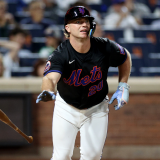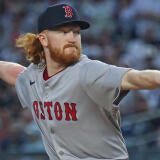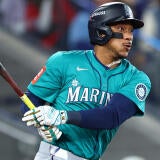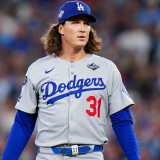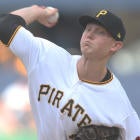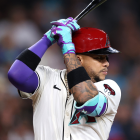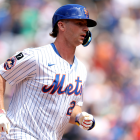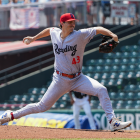Pittsburgh Pirates top prospect list 2020: Mitch Keller and Ke'Bryan Hayes lead the way for an interesting system
The Pirates have a few blue chippers working their way through the system
With the regular season concluding, we've decided to take a look at each team's future -- not by using a crystal ball or other psychic abilities, but by evaluating their farm systems. Below you'll find our ranking of the top five prospects in the organization -- sorted by perceived future potential -- as well as five other players who fit various categories. Those categories are:
2020 contributor: A player who is likely to play a role for the big-league team next season.
Analyst's pick: A player who is a strong statistical performer and/or whose underlying measures are better than the scouting reports suggest.
Riser: A player on the way up.
Faller: A player on the way down.
One to watch: An interesting player to keep in mind (for whatever reason).
These rankings were compiled after talking with various industry sources about the systems (and players) in question. It should be acknowledged that this process is more art than science, and that there are limits to ordinal rankings. Still, it's an intuitive system, and our hope is that the write-ups will answer any questions by providing additional context and analysis of each player -- such as their pluses and minuses; the risk factors involved; and their estimated arrival date.
One last word on eligibility: we're following MLB's rookie guidelines by disqualifying any player with more than 130 big-league at-bats or 50 innings pitched.
Just about everything that could go wrong for the Pittsburgh Pirates did go wrong in 2019. The good news is that there are some interesting prospects at the top of their farm system who should play bigger roles on the 2020 team. That may not be enough for the Pirates to turn things around, but at least it should give the fans something to hold onto.
1. Mitch Keller, RHP
Mitch Keller just qualified for this list, as he nearly topped the 50-inning threshold. What he did during his big-league stay was … well, confounding. He posted strong underlying peripherals -- his strikeout-to-walk ratio was outstanding -- but he also permitted a lot of hits.
Keller's fastball is supposed to be his best pitch due to its combination of mid-90s velocity and rise (the only qualified right-handed starters with greater relative vertical movement on their heaters are Justin Verlander and Gerrit Cole). Yet his command, along with some potentially suboptimal sequencing, led to a .461 batting average against the pitch, as well as a lower fastball swing-and-miss rate than those posted by Jakob Junis and Adam Plutko, among others.
A less surprising, if no more promising development saw Keller record minimal whiffs on his changeup -- the laggard in his arsenal. If there is a bright side, it's that he did establish a third pitch to go with his fastball and curve: an upper-80s slider that missed bats at a higher rate than either of his other pitches. If and how he can leverage those three offerings against left-handed batters will go a long way in determining if he's able to become more than a No. 3 starter.
Some of you may have read those preceding paragraphs and made a mental note that Keller is clearly going to be an Astro someday based on his strengths and weaknesses. For the sake of Pirates fans, here's hoping he finds success before then -- and/or brings back a bounty.
2. Ke'Bryan Hayes, 3B
The book on Ke'Bryan Hayes -- whose dad, Charlie, played in parts of 14 big-league season -- is well-established at this point: he's an outstanding glove at third base with an unfulfilling bat.
Hayes spent this season in Triple-A, where he hit .265/.336/.415 -- that's a .150 ISO, for those keeping score, placing him 10th among the 16 International League players who qualified at third base. Hayes also ranked near the bottom of the league in pull percentage -- not because he lacks the bat speed, but seemingly due to that being his desired approach. One talent evaluator noted his propensity for hitting fastballs into the ground.
To some extent it's understandable if the Pirates don't want to tinker with Hayes's swing. He's almost big-league-ready and he contributes enough defensively and on the basepaths (where he went 12 for 13 on stolen-base tries) to be valuable without hitting for much power. But if his hit tool plays closer to average than expected, he might top out as a middle-of-the-pack third baseman -- that's a fine outcome, it just may cause you to wonder what if?
3. Oneil Cruz, SS
Oneil Cruz has one of the oddest profiles due to his listed size -- 6-foot-7, 175 pounds -- and current position -- shortstop. Dating back to the last round of expansion, Mike Morse (6-foot-5) is the tallest player to receive 100-plus plate appearances while playing at least three-fourths of their games at short. Morse was mostly done as a shortstop by the time he was 24 years old.
Cruz, 21, moves well and quickly enough to remain in the six-hole for now. Heading forward, though, it's anyone's guess if he'll slide over to third, to first, or to the outfield. Wherever he plays, the focus will be on his bat. Cruz's size gives him high-grade power potential. The catch is that his long limbs also lengthen his swing, making him more prone to swinging and missing. To wit, he fanned in more than 26 percent of his trips to the plate in 2019. It's fair to wonder if that rate will increase once he hits the majors -- thus limiting his ability to hit for average.
Because of Cruz's power and the non-zero chance he sticks at a premium defensive position, there's a real possibility he develops into an All-Star-caliber player. If so, the Pirates -- who have been on the wrong end of a few lopsided deals in recent years -- could claim one of their own. Remember, they landed Cruz from the Dodgers in for 20-something innings of Tony Watson.
4. Travis Swaggerty, OF
The Pirates drafted Travis Swaggerty 10th overall in 2018 out of the University of South Alabama -- the same school that has produced, among others, Juan Pierre and Luis Gonzalez.
Swaggerty, as it turns out, has elements of both players evident in his game. He's a well-above-average runner whose speed should permit him to be a defensive asset. Combined with his patient approach, he could also bat near the top of an order -- much the way Pierre did. At the same time, Swaggery has more power potential than he's shown, and it's at least possible he has some surprising home-run totals -- albeit, perhaps, not to Gonzalez's levels.
The drawback with Swaggerty is that he may need to pick a lane -- either prioritize an on-base or slugging-heavy approach. Maybe not; maybe he proves capable of doing all the above. But, at present, he's far too prone to striking out for someone who isn't providing much in-game pop.
5. Quinn Priester, RHP
Quinn Priester was the fourth pitcher selected in June's draft, and the first taken from a high school. He has all the usual traits associated with that achievement: he's tall and lean but in a way that suggests he can put on weight; he's athletic with an easy delivery; and he's shown the potential for three above-average pitches, including a curveball.
Priester won't turn 20 until after next season, so he's years away from reaching the majors. Put a star next to his name for the time being, because he could be something good down the road.
2020 contributor: Kevin Kramer, INF
Technically, Kevin Kramer has already played in the majors; he just hasn't done much with his opportunities. That may continue. Kramer is a so-so defender whose best position is second base because he doesn't throw or run well (his sprint speed was in the 24th percentile). In other words, he needs to hit to sit on a big-league bench. Kramer is so prone to the strikeout that there's no guarantee he does. There's some pop here, so the Pirates should (and presumably will) give him more time to prove whether he's worth keeping or a future waivers fixture.
Analyst's pick: Steven Jennings, RHP
Steven Jennings didn't have the best statistical season -- he posted a 4.71 ERA in 130 innings in A-ball -- and he's not the biggest fellow, but he does possess some innate qualities that teams like. Namely, Jennings has a repeatable delivery and has shown an ability to impart good spin on his pitches. The upside here is something like a No. 4 starter, so bear with him.
Riser: Tahnaj Thomas, RHP
While Tahnaj Thomas is yet to pitch above rookie ball, there's reason to believe he has a bright future ahead. Acquired from Cleveland as part of the Jordan Luplow trade (that's what it's called), Thomas is fast-armed, high-waisted, and employs a Mike Clevinger-like rocker step to begin his motion. He's shown promise in throwing strikes and spinning the ball, giving hope he can remain in the rotation long-term. To paraphrase Dwight Yoakam: he's a thousand miles from Pittsburgh. But, so far as Cleveland fans are concerned, maybe he'll break hearts, too.
Faller: Luis Escobar, RHP
The Pirates gave up the ghost on Luis Escobar being a big-league starter this season, shifting him to the bullpen save for a five-start stretch during the summer. Escobar has a busy delivery and bad command, but can throw three average or better offerings at times, including a mid-90s fastball. He pitched to at least nine batters in 11 of his 29 minor-league relief appearances, suggesting Pittsburgh may use him in a nontraditional, multi-inning role heading forward.
One to watch: Santiago Florez, RHP
Santiago Florez is a big-bodied right-hander with a lively fastball who won't turn 20 until May. He's struggled with his command to the point where he's walked more than four per nine in rookie ball. When asked about Florez, one American League front office member said, "I don't think I know who that is." Now, perhaps, they do.



